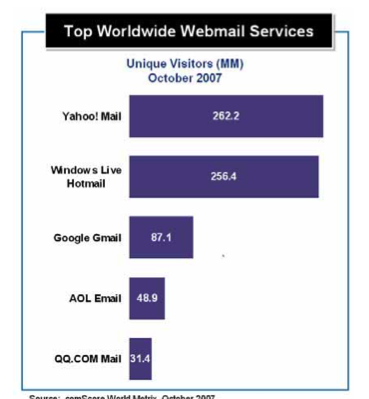March 23, 2008
Broken Finger
 No, that's not my X-Ray. I don't have a copy of mine to post yet, but I do have a swelling broken finger as the result of a difficult to start pressure washer.
No, that's not my X-Ray. I don't have a copy of mine to post yet, but I do have a swelling broken finger as the result of a difficult to start pressure washer.
Oh, and I have Vicodin too.
Now here's the funny part. It's not fixed yet. The x-ray revealed an "interesting" break. That's not my description. The physician's assistant who read them actually said that a few times.
So I'm scheduled to see an orthopaedic specialist at 2:30pm on Monday to determine the best course of action. Meanwhile, it's taped to the medical equivalent of a stick and I'm at home with a loving wife and a small bottle of pills.
Ugh.
It took me nearly 34 years to brake a bone. Not even a pair of skis could do it. It had to be a fancy power tool.
March 20, 2008
Asking as a Substitute for Thinking
 Reading the comments to Patterns for email as work conversation, I came across a comment that hit on something I see all too often (and am certainly guilty of myself):
Reading the comments to Patterns for email as work conversation, I came across a comment that hit on something I see all too often (and am certainly guilty of myself):
I’m definitely trying to get people used to the idea that I may only answer e-mails during two periods a day, but that if they have something quick, I’m available via IM. The issue really revolves around that I need some uninterrupted/uninterruptible chunks of time during the day or I feel like I have ADD, bouncing from issue to issue. Also, to a certain extent, I find that the people who work for me will, if I’m available, use asking me something as a substitute for thinking (this I’ve learned after years of being instantly available and then wondering why the people working for me don’t seem to be developing critical thinking skills).
It's really, really tempting when you're busy and heave deadlines looming to just ask the guy (or girl) who you know will know the answer. Sometimes it doesn't even enter your thinking because you're focused on accomplishing something else. And it's equally hard to estimate the impact of your interruption on their productivity, concentration, and focus.
The real trick, I think is finding a way to handle this that's polite yet firm. And when you're the sort of person who's more apt to say "yes" than "no" when someone asks for help, it's difficult to help coworkers understand that you'd rather they learn to fish instead of coming to you for one when they're hungry.
Do you run into this very often? If so, how do you handle it?
March 19, 2008
Yahoo + Microsoft = Web Mail Dominance
I just ran across this graphic in Dave McClure's Flickr photostream and realized that I never considered what combining HotMail (that name still makes me giggle a bit) and Yahoo! Mail under the same company would mean.
"Web Mail Dominance" kind of jumped to mind.
Granted, I know nothing of the relative growth rates of the services included in that graphic, but even if Gmail does somehow come to rule the world one day, there's going to be a long run of One Really Big Player in the web mail space if the proposed acquisition happens.
Hey, I see that he blogged it too.
Food for thought... or at least a quick mental snack.
March 17, 2008
FeedBurner Implementation Note
Just a quick heads up to anyone who cares (probably only a few of you), as mentioned last night, I've implemented FeedBurner for my blog's main RSS feed on a trial basis.
For most of you, that means virtually nothing changes. At worst, you may see the last 10-20 entries appear as "new" or "changed" in whatever RSS reader you use. And for most of you that's either Google Reader or Bloglines (based on the stats I have already).
If you're interested in the details, the relevant section of my Apache's httpd.conf file now looks like this:
## Blog stuff Redirect permanent /backend.php http://jeremy.zawodny.com/blog/rss2.xml ## Added on 06-19-2006 Redirect permanent /blog/atom.xml http://jeremy.zawodny.com/blog/rss2.xml ## Added on 06-21-2006 Redirect permanent /blog/index.xml http://jeremy.zawodny.com/blog/rss2.xml ## Added on 03-17-2008 Redirect temp /blog/rss2.xml http://feeds.zawodny.com/jzawodn/rss2
That means anyone fetching my rss2.xml file will now receive a temporary (HTTP 302) redirect to feeds.zawodny.com which is, in turn, a CNAME to feeds.feedburner.com.
I implemented it this way so that i can turn if off at some point (by removing the redirect) and not "lose" subscribers. Unless, of course, some folks subscribe directly to the FeedBurner hosted copy.
In any case, I'm curious to see what the FeedBurner stats look like. I'm sure there are a few settings I need to tweak. I've probably missed a few. So don't get all paranoid about click tracking and whatnot. My goal is to do little of that.
In New York City for the Business of APIs Conference
 I tried to post this late last night but my laptop managed to freeze up on me. Gotta love this modern technology, no? And this morning the hotel Wifi is still down and my EVDO card is struggling to keep up with me. And there's some crazy jackhammer work going on outside that's been driving me nuts all morning too.
I tried to post this late last night but my laptop managed to freeze up on me. Gotta love this modern technology, no? And this morning the hotel Wifi is still down and my EVDO card is struggling to keep up with me. And there's some crazy jackhammer work going on outside that's been driving me nuts all morning too.
Yay!
Anyway, I'm in New York City today for the Business of API's Conference at the Yale Club, which sounds way fancier than anything you'd normally find me at. At about 1:30 eastern time I'll be speaking for about 20 minutes about Yahoo!, Openness (as recently noted), APIs, and that sort of stuff.
If you're at the conference and happen to see this, please do introduce yourself.
I'd love to meet up with other folks in NYC, but this is an unfortunately short trip. I'm flying back to the Bay Area on Tuesday morning to get some stuff done at the office in the afternoon.
We've got a lot to do before the Hadoop Summit next week.
But at least the weather appears to be nice, even if I don't have a good view out from my hotel room.
My goal for this trip is not adapting to the local time zone, so that I can get back to normal soon after my arrival back home. Let's see how well that works in practice...
Lastly, I may be playing around with FeedBurner soon. But that should be mostly transparent to subscribers--aside from a maybe a one-time "reset" of what's in my RSS feed. More on that when it happens.
March 14, 2008
Openness is not a Poison Pill at Yahoo!
Mary Jo Foley asks Could Yahoo’s ‘openness’ be another anti-Microsoft poison pill?
Yahoo traditionally has been and continues to be a big open-source backer. It runs its datacenters on open-source software (something Microsoft officials have said they don’t intend to rip and replace immediately — while avoiding saying never).
But over the past couple of weeks, Yahoo has really been banging its “we’re more open than ever” drum.”
Yahoo announced in mid-February that it had implemented what it believed to be “the world’s largest commercial application of Apache Hadoop Java-based distributed-computing framework.” Yahoo is using Hadoop to process its Webmap, which is its “application which produces the index from the billions of pages crawled by Yahoo Search,” according to the Yahoos.
I can honestly say from my vantage point that openness at Yahoo! has nothing to do with Microsoft or any other would-be suitor.
We've been on the openness road for a long, long time at Yahoo. And we take it rather seriously. Some times it hasn't been as visible as others, but believe me, the trend is quite clear when you look at all the data. The Open Source adoption and work. The APIs. The way we communicate with users and partners. The Blogs. The RSS feeds.
I'll be speaking about a small bit of this at the Business of APIs Conference in New York on Monday. And also at the upcoming Open Source Business Conference. And, of course, the Hadoop Summit too.
You'll be reading more and hearing more about openness at Yahoo! from me and Yahoo's much higher up the food chain in the coming months.
Anyone who knows me knows that I come from open source roots and am a big proponent of opening things up more and more. I'd have left Yahoo! years ago if I didn't see it happening.
If you think the last few weeks are big, you haven't seen anything yet! :-)
March 13, 2008
Job: Architect/System Architect at Time Bridge
There's a job on my job board that some of my readers may find interesting. I won't quote the whole listing here, but Architect/System Architect at Time Bridge could be a fun role for someone who wants to get into the world of Web 2.0 business applications.
We are looking for a seasoned System Architect who is passionate about building truly useful Web applications. You will be a key member of the technical team that will design and build the company’s next generation system and you will play a foundational role in delivering a new platform to increase productivity and collaboration around scheduling, managing time and holding meetings. To succeed in this position you must be incredibly smart, committed to good technical design, and driven to get things done. You will work closely with senior management and talented marketing and technical staff. As System Architect, you will be primarily responsible for the architecture of our meeting scheduling system and for driving innovation throughout the product. The right candidate will have experience with multi-platform applications, will understand and have designed distributed, high-availability systems, and will have the vision to understand how small technical details affect the way users see and experience the end-product. This position will report directly to the VP of Engineering and Operations.
Disclosure: The VP of Engineering and Operations at TimeBridge is a former colleague.
From what I've heard about the company, they're doing some very good work there. Check it out if you're at all interested (and qualified).
As a reminder, you can browse all the jobs on my job board and post your own quickly and easily. They'll appear on my sites and other popular technology sites in the network. There's even an RSS feed for the jobs.
Also, special thanks to the folks at TechCzar for their translation of selected posts from my blog and including them in their growing blog network.
March 11, 2008
Wal-Mart and Linux: No Surprise
 I hope that nobody is surprised by Wal-Mart's decision to stop selling Linux boxes (in the form of the gPC). Despite what some folks may think, Linux on the desktop is perpetually one year off.
I hope that nobody is surprised by Wal-Mart's decision to stop selling Linux boxes (in the form of the gPC). Despite what some folks may think, Linux on the desktop is perpetually one year off.
I know this because I've hoped and hoped myself over the years, running Linux on various desktops and notebook, suffering through driver problems, document incompatibilities, and so on.
But that doesn't meant that things aren't getting better. When I made the move from RedHat to Debian, a whole class of problems went away. I stopped building stuff from source most of the time (with a few exceptions). I didn't have packaging and installation/upgrade hassles anymore.
And nowadays, with Ubuntu on half of my computers, I don't even have driver problems anymore. Plus, with Firefox and Open Office, I can deal with just about any documents I'd need to. The only real problem is the software that simply doesn't run on Linux. And for that I could install VMWare, VirtualBox, or similar technology to run a version of Windows on top of Linux.
The fact that mainstream America still wants Windows says far more about Windows than it does about Linux. This is not at all surprising to someone like me--someone who's been waiting "one more year now" for the last 5-8 years.
And you know what? That's okay.
Different people want different things.
March 10, 2008
The "No Laptop" Meeting Rule
 I'm not about to call this a trend yet, but I've seen a few meetings at work in recent months that advertised and enforced a "no laptop" rule.
I'm not about to call this a trend yet, but I've seen a few meetings at work in recent months that advertised and enforced a "no laptop" rule.
Part of me thinks that it's a great idea. There are meetings I've almost skipped or found fairly useless because a significant proportion of the people in the room were suffering from continuous partial attention and often seemed lost or constantly behind the curve.
Another part of me thinks that it's absolutely ridiculous that we have to mandate common courtesy and force people off their laptops long enough to have a useful meeting.
I wonder what, if anything, schools (mostly college) are doing to help ensure that this isn't a problem in the workplace as more and more students start working full-time. Do they know how to put away the laptop or cell phone when the time comes?
Maybe the problem is that the people "at the top" of many companies set a bad example, walking down the hallway with their eyes glued to a Blackberry screen or constantly plugged into a Borg-like bluetooth headset.
Have you seen "no laptop" meetings starting to emerge in your organization yet?
March 06, 2008
Herding Cats: Funniest Video Ever
It's hard to believe that this video has been on YouTube since 2006 and I hadn't seen it until yesterday, but the Internet has a lot of tubes. It's hard to watch 'em all.
Anyway, I suspect that most readers are familiar with expressions built around the phrase herding cats:
The phrase herding cats comes from the common saying that something involving coordination of many different groups or people is as difficult as herding cats. One of the commonly encountered uses of the term in technical fields is the phrase "Managing programmers is like herding cats" or "Managing engineers is like herding cats". In education it would be "Managing students is like herding cats". In reality, it would be "Managing cats is like herding cats." It refers to the individualism common in the stereotypical examples of programmers and domesticated cats. A similar phrase, allegedly of Irish origins, is "Minding mice at a crossroads".
Needless to say, it gets used all the time in software engineering groups. That's why this video is so damned funny.
Not only is it very well produced and conceived, it's incredibly funny in the way it takes an otherwise silly phrase and brings it to life in exactly the way you'd expect. Given that International Day of Awesomeness is just around the corder, I feel justified in saying... AWESOME!
March 05, 2008
Yahoo! FireEagle: Personal Location Service Platform for Developers
Today FireEagle launched as an invitation-only beta for developers to start testing. I think of it as a personal location service platform, but the more formal description comes from the announcement on the YDN blog:
Fire Eagle is an open location services platform offering web, mobile, and desktop developers a simple way to build new location-based applications while also ensuring that consumers have complete control over their data, including how, when and where their location is made available. Want to easily make your site responsive to a user's location? Or, maybe you've found a way to capture someone's location and you want to find cool apps to plug it into? By doing the heavy lifting and connecting you to a community of geo-developers, Fire Eagle makes it easier to build location-aware services.
Tom Coates was the ring leader for FireEagle and talks about it in this video shot earlier today at ETech 2008.
Don't be put off by the downer of a headline that TechCruch used ("Yahoo’s “Twitter For Location” Goes Into Private Beta With Near Zero Functionality"). I think that Mike Arrington either got the wrong message from someone or misunderstood what FireEagle really is today.
It's a location platform for developers to build on. It has an API that, among other things, lets you worry less about handling geo data and easily build in support for your web, desktop, or mobile application.
It's currently not aimed at end users or "consumers" (oh, how I hate that term). I'm sure the analogy to Twitter was intended to be a loose one.
Congrats to Tom and team for getting FireEagle out the door. :-)
VentureBeat has good coverage here: Yahoo’s FireEagle location service to launch publicly today
Oh, BTW... FireEagle uses OAuth for authentication!
March 03, 2008
Scary Airbus A320 Crosswind Landing Video
Thanks to Thomas Kruse, I present you with the video of an Airbus A320 making a difficult crosswind landing in Hamburg, Germany.
What I wonder is when the pilot made the go-around decision. Everything I've read tells me that the jet engines in use on modern airliners take a few seconds to produce full thrust from and idle (landing) power setting.
I suspect there were a few moments of doubt about whether or not he'd be able to salvage it. Then again, I'm sure the passengers were pretty skeptical at one point too! :-)
